Thomas Tuchel believes in Chelsea’s plan A, but he’s also not one to rest on his laurels. The immediate shift to a back three allowed Chelsea to defend much better at the cost of some of their forward momentum. Last season at least, three at the backs ability to create overloads was enough. This season, not so much.
Finding the exact cause of the attacking issues has been the hot topic as of late. Is it Romelu Lukaku’s addition that is causing issues? Is it being a bit found out? Maybe it’s the more recent switch to more of a 3-5-2 and the players are either unsuited/unaccustomed?
Speaking ahead of the Malmo match, Tuchel believed three at the back could be improved upon. At the same time, he didn’t dismiss the idea of a formation change to add more attackers. The closest Chelsea has got to a four at the back this season was against Aston Villa in the League Cup, but even that still had plenty of shades of the 3-5-2. So, what are the solutions and the tradeoffs?
Let’s start with the big tradeoff: defense. Can any combination of centerbacks with fullbacks cover for the current back three and wingbacks? That extra defender goes a long way towards allowing the wingbacks to press and the midfield to be more adventurous. Plus, the spare centerback creates an extra wave of pressure to slow down counters. The Blues have tried four at the back a few times under Tuchel and it has rarely impressed comparatively.
The big advantage is that extra player somewhere higher up the field. Currently, the 3-4-3 and 3-5-2 will turn into a 3-2-5 or 3-2-4-1 shape on offense. Four at the back generally turns into a 2-3-5 or 2-3-4-1 shape, allowing an extra player for switching flanks. Usually, the hardest question for clubs to answer is who fills out that five up top. The wingbacks tend to provide the width but fullbacks doing the same would do so with the knowledge that there is less protection on a counter over the top. That will make them more cautious and could collapse the whole idea.
Another question to answer is what type of midfield. Currently, the pivot works because one player can get forward on the press (more on that momentarily) and the other can form a diamond with the back three. This forces play wide and stalls the opposition enough for teammates to get back. The pivots that work in a 3-4-3 wouldn’t work nearly the same with four at the back.
There is one potential work around to that and one Tuchel favored at Paris Saint-Germain: a player capable of playing centerback and midfield in equal measure. Marquinhos would often shuttle between midfield and defense, both in a 4-3-3 as the deepest player and in a 4-2-3-1 as one of the pivot players. Trevoh Chalobah and Andreas Christensen could both perform this role. Reece James or even Cesar Azpilicueta would be another option coming from right back to midfield, but then the Blues would need a true winger on the right flank.
Perhaps more than anything, Tuchel will want to maintain the 3-1 press his side normally uses. Generally, one of the midfielders will come out of the pivot to occupy a player with the front three doing the same. This forces the opponent long where Chelsea tends to win the ball when a centerback steps up to challenge. With Lukaku’s pressing being less than aggressive, those three players are very important to forcing mistakes out of the opposition. Any formation will have to maintain that idea while having a solid enough shape behind it in waiting.
If a four at the back switch occurs, it will come in one of three shapes: 4-3-3, 4-2-3-1, or 4-2-2-2. The 4-3-3 would require that player capable of shuttling between defense and midfield more than any other shape. Plus, one of the midfielders would have to get forward to support the press. 4-2-3-1 would have that player ready to press already, but that pivot would need to be exceptionally disciplined and in tune with their teammates to prevent being overrun on and off the ball. 4-2-2-2 would have a similar issue, but it would allow the two striker approach Chelsea has played with as of late. The main issue with 4-2-2-2 would be how easy it would be to get in each other’s way up top with two “wingers” being tucked in and the two strikers both trying to connect and score.
All things considered, 4-3-3 seems like the easiest switch and this team was largely built for it under Frank Lampard. Perhaps the hardest thing to configure will be the midfield. Could Jorginho do that shuttling role well enough? What of Ruben Loftus-Cheek who has found a new avenue for his career playing in the deepest role? Would Tuchel trust Chalobah to be that player shuffling? Is there a right winger that would allow James to do it? There are a lot of questions, but at least fewer than there would be with other four at the back shapes.
For now, expect 3-4-3 and 3-5-2 (hopefully switching to more of a 3-4-1-2) to continue. But with this next run of fixtures being on the lighter side, don’t be surprised if Tuchel uses late moments or entire games to experiment some new ideas.
